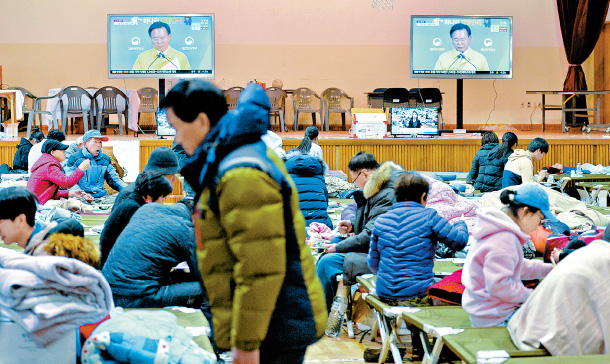Pohang quake leaves 1,797 people displaced

Residents of Pohang, North Gyeongsang, displaced due to the 5.4-magnitude earthquake that hit the city Wednesday, remain at the hall of Daedo Middle School in Pohang on Friday. About 1,700 people forced out of their homes due to the quake are staying at 10 evacuation centers throughout the city. [NEWS1]
The 5.4-magnitude quake in Pohang on Wednesday injured 75 people, destroyed some 1,300 properties and drove 1,797 people out of their homes as of Friday morning, according to the central disaster and safety management office under the Ministry of Interior and Safety.
Hundreds took shelter at a gym in Heunghae town, but most cannot go back home because their homes have been damaged or the water and electricity lines have been disconnected.
Many lived in the Daesung apartment complex in the town, one of the most damaged structures. One of its six apartment buildings appears slightly uprooted, leaning at a slight angle.
“You can see here that the building appears to have been somewhat uprooted from the ground during the quake,” said Kim Jin-ku, professor of architectural science at Sungkyunkwan University, in examining an external wall of the Daesung apartment complex.
“That means this construction may have been haphazardly done from the very beginning.”
Experts criticized the complex’s poor construction.
“Through the cracks in the apartment wall, you see that the reinforcement steel has been disconnected in the quake,” said Kim Tae-wan, professor of architectural science at Kangwon National University in Gangwon.
“The reinforcement steel is the very bones of a structure and if they are not placed well, then the buildings become more vulnerable to quakes.”
One expert who examined the Daesung apartment complex on Friday said residents had better move out because “it does not meet the safety standards and should be knocked down.”
Experts also examined some of the pilotis-based houses, structures built on columns or pillars that raise the building above ground, which were also damaged.
“This building had it coming,” said an expert after examining a damaged pilotis-based house in Buk District. One pillar was ripped through in the middle, with rebar poking out in places.
“The steel bars broke out of the pillar under the pressure from the quake,” said Kim Tae-wan. “And what’s more, drain pipes have been installed among the steel bars, which weaken the bars’ strength.”
“This pilotis-based house will remain vulnerable to quakes even if renovated and bolstered,” said Kim Jin-ku.
“But not all pilotis-based houses crumble at quakes,” said Jung Gwang-ryang, president of the Korean Structural Engineers Association. “They can be built from the start to be more quake-resistant with an expert involved.”
The Pohang city government said it will try to provide temporary housing for those displaced.
“We will speak with the Ministry of Land, Industry and Transport and see if we can provide temporary places to stay for the displaced at some empty apartments and houses owned by the Korea Land and Housing Corporation,” said Lee Kang-deok, mayor of Pohang.
“But the process of examining the current houses of the displaced to find out whether it is safe to go back or not, and securing temporary housing for them may take a few days.”
“We will open up some 160 apartments and houses of Korea Land and Housing Corporation for the displaced,” said Minister of Land, Industry and Transport Kim Hyun-mee in speaking with residents of the Daesung apartment complex on Friday.
Experts are analyzing why the quake appears to have caused more severe damage than the 5.8-magnitude quake that hit Gyeongju last year, which damaged 1,110 properties and injured some 23 people.
Reasons may include the fact that the Pohang quake took place closer to the ground surface than in Gyeongju, the difference in population density and the differing movement of the fault zones underground.
The Pohang quake took place 8 kilometers (5 miles) under the ground, while the quake in Gyeongju took place 15 kilometers deep.
The quake hit a point 9 kilometers north of Pohang’s Buk District, which is home to about 270,000 people. The quake in Gyeongju hit an area some 8 kilometers southwest of Gyeongju, where farmers lived scattered across and in small groups.
“There is also a possibility that a reverse fault [when the hanging wall moves up against the foot wall] caused the quake in Pohang,” said Woo Nam-cheol, a geologist at Korea Meteorological Administration. “That would explain why the Pohang quake caused more damages than the Gyeongju quake, which was a strike-slip fault [when the hanging wall and the foot wall moves side-by-side, in a horizontal movement]. But we need more time to analyze what really happened in Pohang.”
The Pohang city government said it is planning a more detailed inspection on structures throughout the city to see what measures are needed to make the city more quake-resistant. There are about 1,600 public structures in the country which have been acknowledged by the central government to be quake-resistant. Pohang is home to only eight.
Pohang continues to experience aftershocks Friday, totaling 50 since Wednesday.
BY CHOI EUN-KYUNG, KANG CHAN-SU AND ESTHER CHUNG [chung.juhee@joongang.co.kr]










with the Korea JoongAng Daily
To write comments, please log in to one of the accounts.
Standards Board Policy (0/250자)